12 Expert Ways To Use Za'atar In Your Cooking
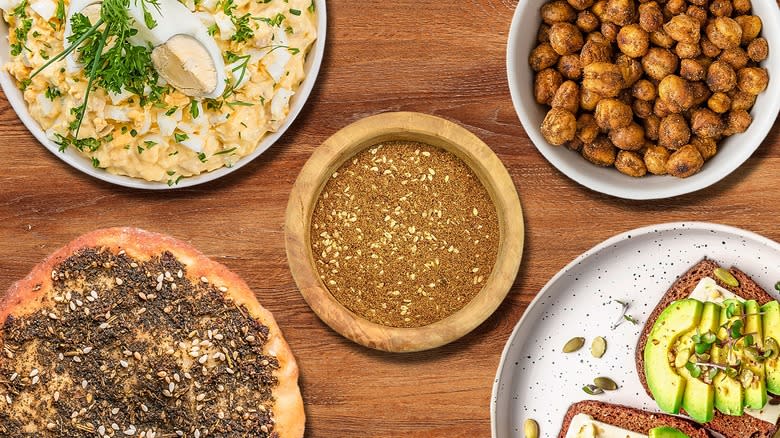
There are few ingredients as emblematic to Levantine cuisine as za'atar is. Most Lebanese, Syrian, Palestinian, and Jordanian households have a jar of za'atar in their pantry, whether it's store bought or homemade. It's as important to the levant as olive oil, and often, these two go hand in hand, eaten together in various ways. Made from a dried herb of the same name, a wild oregano called za'atar, sesame seeds, salt, and sumac, it's a fragrant, woody, lemony, earthy, savory condiment that seems to go well on most things.
Gaining popularity in different parts of the world, this unassuming herb and spice blend has become relatively easier to find on restaurant and cafe menus, as well as mainstream stores. However, if you're looking for an authentic blend, it's always best to visit a Middle Eastern grocery store to get a tasty and affordable blend. Plus, you can make your own at home with this easy homemade za'atar recipe.
As someone of Middle Eastern heritage, I grew up eating za'atar, often without thinking about it. Since becoming a recipe developer, I've grown a deep love for it and use it in my daily cooking. It's a truly versatile blend and can enhance many dishes, both the traditional and the new. As an all-purpose seasoning, za'atar is great for flavorful meals throughout the week, from breakfast to dinner, and the snacking in between. Here are some ways to use za'atar in your cooking.
Read more: The 20 Best Olive Oils For Cooking
Za'atar And Olive Oil Dipping Oil
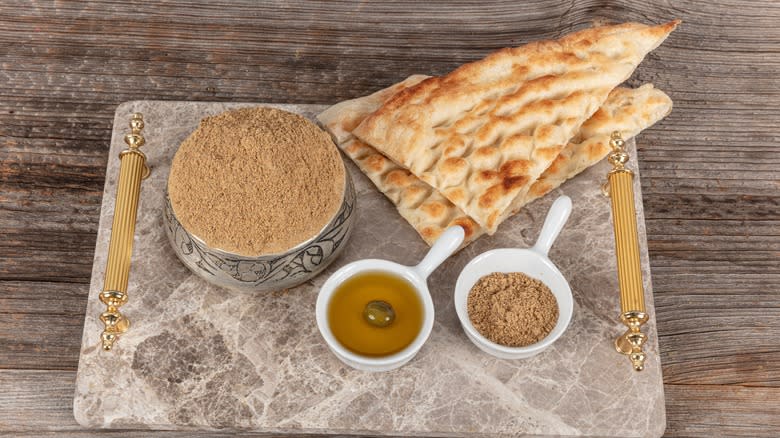
One of the most traditional ways that people eat za'atar is simply with fresh bread and olive oil. This is how I grew up eating it, and it was one of the most satisfying snacks to have in the afternoon in between meals. Fresh bread is a must and there are two ways of dipping. The olive oil and za'atar are either placed in separate bowls or mixed together to make a herby dipping oil. If they're separate, you break off a piece of bread with your hands, then dip it into the olive oil, followed by dipping that into the za'atar. The olive oil makes the za'atar stick to your bread.
However, an easier way to do it (and requires fewer dirty dishes) is simply to mix them together in one bowl. You don't need to measure anything because it's hard to go wrong. Just add a couple of glugs of extra virgin olive oil to a bowl, then sprinkle in or spoon in some za'atar and mix together with a spoon. It's ready to eat, and you can spoon it over some bread and enjoy. You can also play around by using differently flavored olive oils like garlic or truffle olive oil, but it's really tasty plain, too.
Salad Vinaigrette
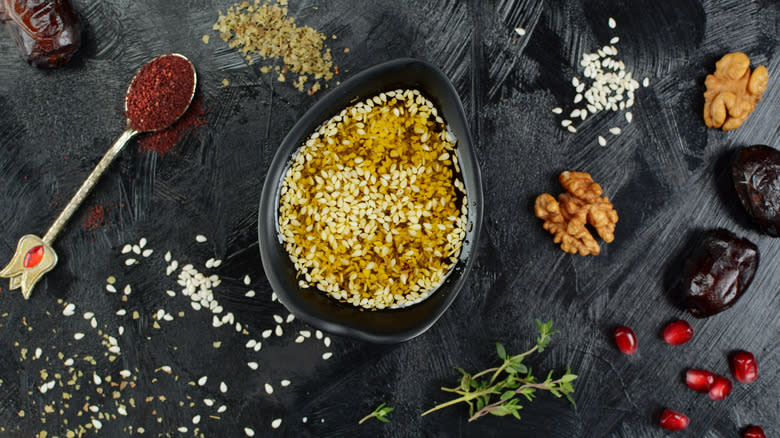
Nothing makes a fresh salad better than a zingy vinaigrette. The way you dress your salad is what makes it, and it doesn't matter how exciting or extravagant your salad ingredients are; it's likely to be bland if you don't make a tasty dressing for it. It's the thing that brings it all together and makes it one cohesive dish. Growing up with Middle Eastern cuisine, the table was not finished without a fresh, crisp salad. Made with whatever seasonal vegetables were available at the time, salad was never an afterthought or something you ate because it's "healthy." It was just one of the delicious components of the meal, and this was all down to the za'atar vinaigrette.
The bonus of using za'atar in a vinaigrette is you need very little else to make it come together. It's salty, lemony (because of the sumac), and pure herbaceous flavor, dressing some crisp veggies, making them incredibly appetizing. Just add a teaspoon or two of za'atar to some olive oil and vinegar, give it all a shake and drizzle over your salad. You'll never look back.
Sprinkle On Avocado Toast
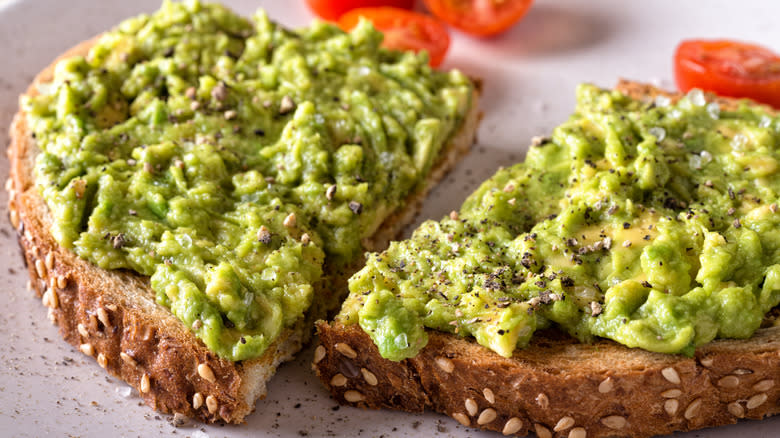
Avocados on toast have become a favorite easy snack or go-to meal for many people around the world. The creamy avocados are satisfying and filling while providing a relatively neutral flavor base, creating an opportunity for all kinds of flavor toppings. Some keep it simple with lemon and salt, while others add eggs, hot sauce, and all kinds of other toppings. Za'atar is an obvious choice for a topping, especially because the citrusy sumac adds a lot of brightness and is an ingredient that can give your avocado toast new life. Of course, you can simply add some sumac, but adding a za'atar blend that includes sumac gives you a more full-bodied flavor as well as a pleasant, crunchy texture.
Using za'atar on your avocado toast is great because you can only add za'atar and have a really delicious toast, and you can add it in conjunction with all sorts of other toppings like eggs, tomatoes, feta, ricotta, pickled veggies, and more. Why not experiment with some combinations and see what you like the most?
Finish Off Your Shakshuka With Za'atar
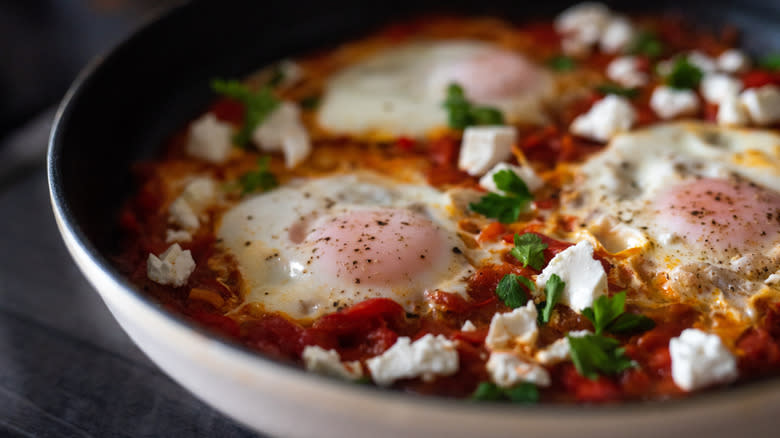
Shakshuka is one of those dishes that everyone should have in their wheelhouse because of how handy it is. It's relatively fuss-free to make, uses things you probably already have in your kitchen, and makes a really delicious meal for any time of the day. I make shakshuka at home at least once a week, and no matter what, it's always something my family looks forward to eating. It's also incredibly forgiving, and you can customize it however you like, including adding handfuls of za'atar to it.
This North African dish (with origins in Tunisian cuisine) tomato-based egg dish is made to be enjoyed how you like it, whether you like crumbling some feta on top, adding chiles, sausages, greens, or keeping it simple. While za'atar isn't a traditional topping for shakshuka, it really makes sense because it's normal to add za'atar to eggs anyway and it goes incredibly well with the North African flavors of shakshuka. You can cook shakshuka the way you usually would, and just before serving, sprinkle a few teaspoons of za'atar on top. It takes the shakshuka to new heights, making it even more savory and delicious.
Make Manakish
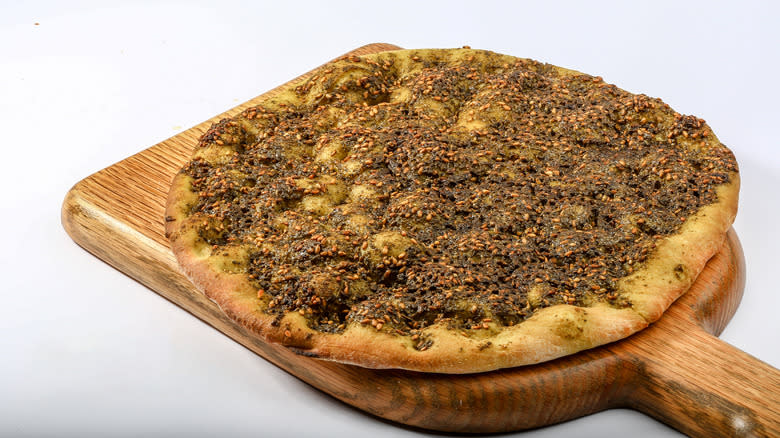
Many cultures have a version of a cooked savory dough that they eat for breakfast or as a snack. In Lebanon it's a manousheh (singular) or manakish (plural). A tender flatbread is cooked, and in a similar appearance as pizza, is usually round and topped with a mixture of olive oil, salt, and za'atar to make the most yummy and savory treat. It's as ubiquitous in Lebanon as baguettes are in France, and you can find them in many street food vendors, cafes, and delis, and the aroma of freshly baked bread and za'atar fills the air everywhere.
Manakish are an important part of a Lebanese breakfast, a meal that holds cultural significance and importance in Lebanon. Manousheh has been included as one of UNESCO's Representative List of the Intangible Cultural Heritage of Humanity. You can get larger ones and smaller handheld ones, with a bunch of customizable toppings like labneh, sujuk (sausage), tomatoes, and more. They're super easy to make at home, and if you want a major cheat shortcut, you can use ready-made pita bread or tortilla wrap as your bread base and bake it with olive oil and za'atar. It's not only great for breakfast but any time of the day.
Make Za'atar Roast Potatoes
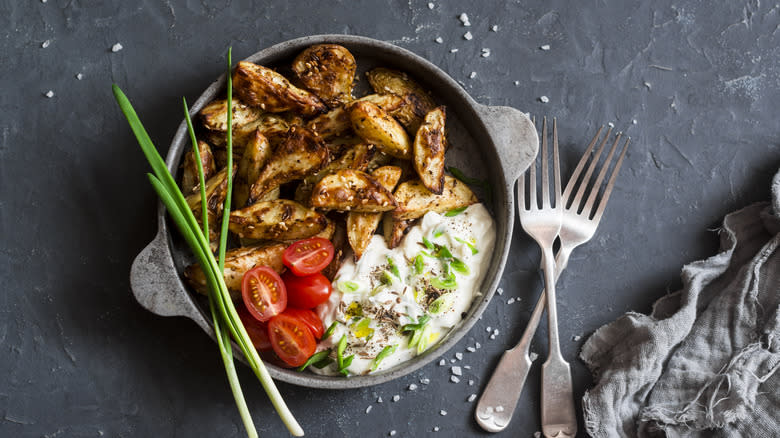
It's hard to find someone who doesn't like potatoes, and many meals are only made infinitely better by adding a side of roast potatoes to them. This already perfect food doesn't need much else except your favorite seasonings. However, if za'atar isn't part of your favorite roast potato seasonings, you're missing out. If you haven't tried it, you should consider using za'atar the next time you make potatoes. They are a match made in heaven and go so well together that it's a must-try for anyone who loves this humble spud.
Drizzle your potatoes with some olive oil, and let it rain with za'atar over them. Give your potatoes a mix to make sure the za'atar is evenly spread all over them and then roast the potatoes as you usually would. (A little garlic doesn't hurt either). If you prefer to fry your potatoes, then you can add the za'atar as they come out of the hot oil. As za'atar already has salt in it, you may want to add less salt or not at all without tasting first to avoid over-salting.
Za'atar Whipped Feta

Whipped feta took the internet by storm some time ago because of how easy it was to make a dip or appetizer creamy and heavenly. Taking a block of salty feta cheese and blending or mashing it up with some thick plain yogurt transforms these two dairy products into one uniform, velvety texture. The yogurt mellows out the feta while the feta bolsters the flavor of the yogurt, making it a moreish dip that you could pair with all sorts of yummy toppings. While olives, roasted grapes, marinated tomatoes, and onions, or even some grilled fennel work brilliantly with whipped feta, a dash of za'atar adds all the sophistication with only one ingredient.
Za'atar adds the right amount of earthiness to whipped feta, making it slightly nutty, salty, and herbaceous all at once. Along with a drizzle of olive oil, you've got yourself a really impressive dip to serve as a snack at your next dinner party that comes together in less than a minute. Serve with some toasted pita chips or even some breadsticks or tortilla chips. There's a risk it will get eaten up in no time, so make sure you get a taste before putting it out.
Za'atar Egg Salad

Egg salad is as classic as it gets, and while it has its loyal fans who love it as is, it could do with a little sprucing up for a more exciting twist. Za'atar effortlessly adds this unique twist to egg salad without needing to take any extra steps. It takes the flavor up a notch without detracting from the essence of a classic egg salad. It's an intuitive choice of herb blend because za'atar and eggs go great together, adding flavor to the creamy mix. Plus, the sesame seeds add a nice mouthfeel and crunch to the otherwise mushy texture.
To make a za'atar egg salad sandwich, you can add a sprinkle or more of za'atar to your mayonnaise and give it a good mix before adding everything else. You can also add it to your individual sandwiches instead of in the egg mixture in case it's not to everyone's liking. Then, spoon some over your eggs before closing your sandwich. What's great about doing it like that is that everyone can add as much or as little as they prefer.
Za'atar Roast Chicken

There's little as homey and comforting as roast chicken, especially one you've cooked yourself. It's one of the few foods that looks quite complex to make but is actually as simple as placing ingredients together and letting your oven do all the work. If you want to make a tasty roast chicken with even less effort, za'atar is the answer. It seasons your chicken while imparting a more complex flavor than your regular chicken spice mix. You can use it as a finishing seasoning for sure, but it's also great to use in a marinade to give your bird a deeper flavor.
Za'atar is also a great ingredient to use as a rub or to include in your favorite herb and spice blend. You can use this as a dry rub or dry brine for chicken and other poultry to make the perfect roast with crispy skin. Or, you can use za'atar in a slightly different way by making a roast chicken with za'atar stuffing. Combine pieces of bread with some lemon, za'atar, garlic, and oil to make a delicious stuffing that's not limited to just chicken. Why not add it to your holiday turkey stuffing this year for something more unique?
Season Roasted Chickpeas With Za'atar
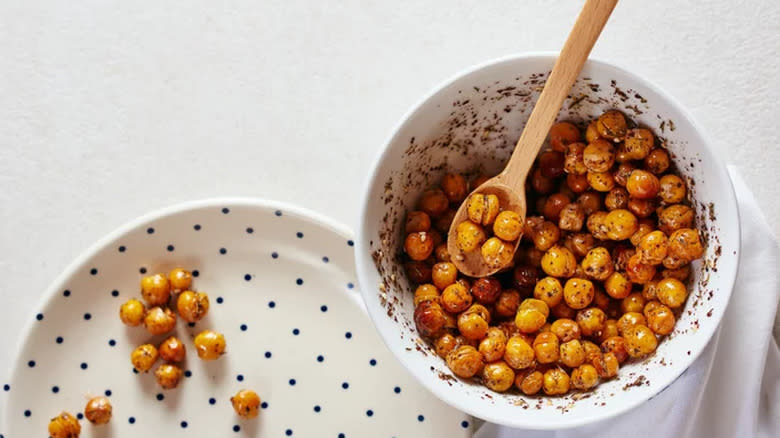
Chickpeas are often associated with Middle Eastern and North African cuisine in dishes like hummus, fatteh, or leblebi. However, they also make for a great snack on their own as roasted and spiced chickpeas. They become super crisp on the outside, akin to deep-fried chickpeas, while being fluffy on the inside. This makes for a satisfying texture that makes you want to keep eating. In terms of taste, they can take on any spice or seasoning you like. While spices like paprika, or cumin can taste great on chickpeas, za'atar is an easy choice and make really flavorful crispy bites.
You can use za'atar on its own and have a full flavored chickpeas, or why not make this easy roasted chickpea with za'atar and maple for a sweet, salty and tangy snack. The trick to crispy chickpeas is to pat them completely dry before cooking. Then place them in the oven with nothing on, and add your za'atar, oil and maple syrup as soon as they come out of the oven. Give them a shake, and enjoy.
Watermelon, Feta, And Za'atar Salad Will Surprise You
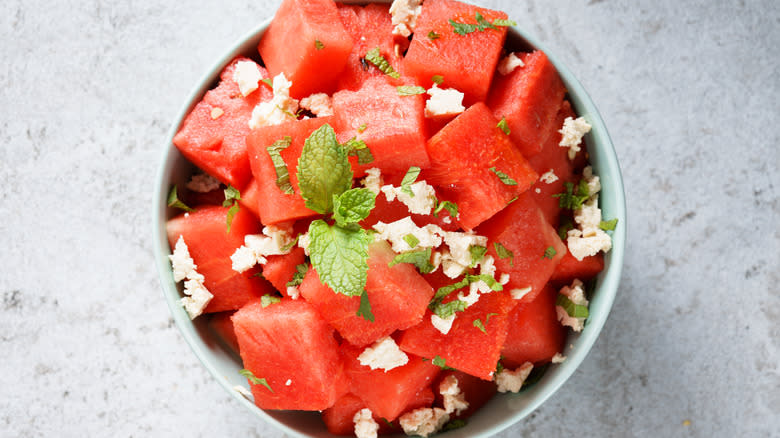
While the combination of watermelon and cheese has caught on globally in recent years, it's a classic snack that marks most people from the Middle East's childhood. Perfect for a hot summer's day, a slice of watermelon wouldn't be eaten without a side of white, salty cheese like feta, whether as a snack, an after dinner "dessert," or as the meal itself when it's too hot to turn on the oven or stove. Now za'atar comes into the picture, and you've got yourself an elegant summer salad, perfect to take to any barbecue or picnic.
Watermelon and cheese together are incredibly satisfying, savory, and sweet, creamy, juicy and crisp, all in one bite. This combo, which drew shock from my childhood friends at the time, has now been popularized in many parts of the world. You can often find it in the form of salads, often served with mint, and other crunchy veggies. While fresh mint is great, adding a sprinkle of za'atar takes this to new heights. It might seem like adding za'atar to watermelon is a bit out there, but when mixed together in a salad with some feta, it becomes the perfect savory unifier.
On Grilled Steak
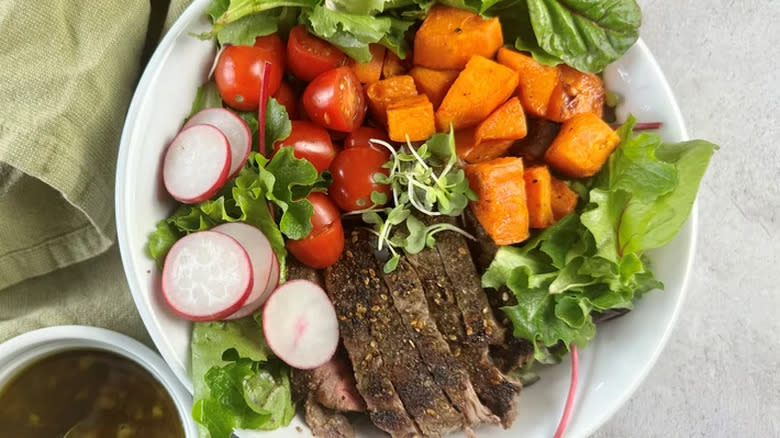
Many of the uses for za'atar are for vegetarian dishes, bread based foods, or eggs. However, za'atar goes just as great with meat as it does with all the other dishes. You can use it as a seasoning for grilled steak or even use it to form a crust on a rack of lamb, similar to a dukkah crust.
You can mix za'atar with some oil and other spices to make a delicious marinade for your meat. Then slather this all over your meat and leave it to marinate overnight for the most flavorful barbecue or grilled meat. It would work great with pork chops, beef, lamb, or even on some grilled fish. You can also just use it as a finishing seasoning on a grilled steak. If you're looking for a nutritious and tasty weeknight dinner, why not try this grilled za'atar steak and sweet potato bowl? Because za'atar goes great with just about anything, you can fully customize it with whatever veggies you have in your fridge.
Read the original article on Tasting Table.

 Yahoo Lifestyle
Yahoo Lifestyle 
